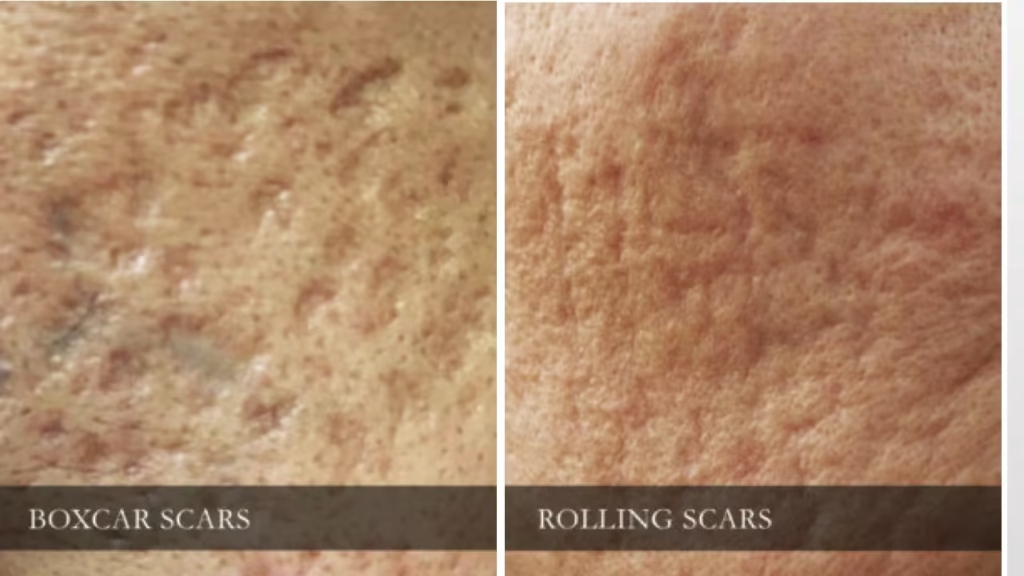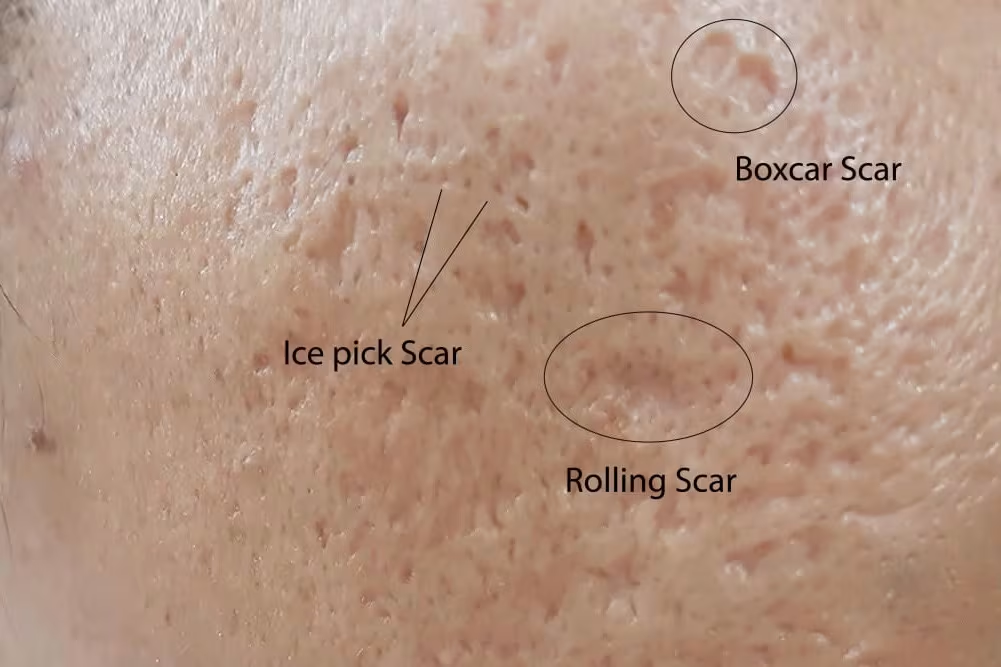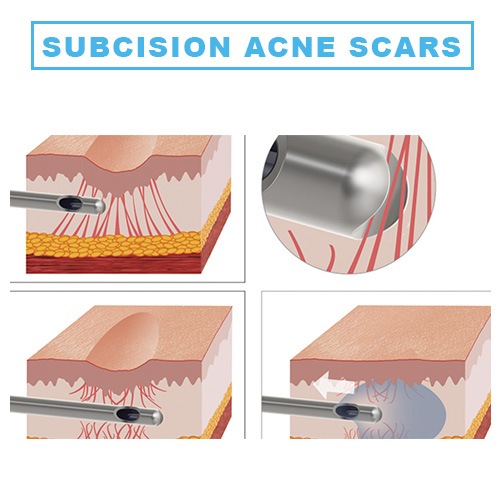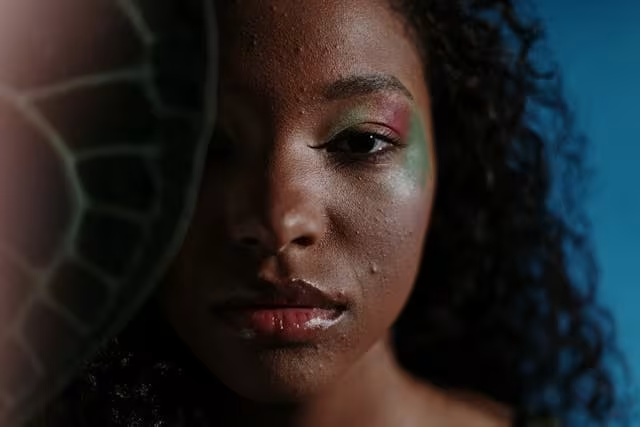Acne scars can persist long after active breakouts have resolved, affecting both appearance and self-confidence.
Among the most common types of acne scarring are rolling scars and box scars, which create uneven skin texture and require specialized treatment approaches.
Understanding these scar types and the available treatment options can help you make informed decisions about improving your skin’s appearance.
Read more: INFINI RF Microneedling: Treat Your Acne Scars
Understanding Rolling Acne Scars vs. Box Scars

Rolling Acne Scars: The Wave-Like Depressions
Rolling acne scars develop when fibrous bands of tissue form beneath the skin’s surface, creating characteristic wave-like or rolling depressions across the affected area. Key characteristics include:
- Wave-like appearance with soft edges
- Result from tissue tethering beneath skin
Box Scars: The Sharp-Edged Depressions
Box scars present as round or oval-shaped depressions with steep, well-defined vertical edges. These scars create a distinctive appearance with several defining features:
- Round depressions with sharp borders
- Commonly found on cheeks and jawline
You might like: The Ultimate Guide to Acne Removal in Singapore
Why Multiple Scar Types Often Coexist

It’s important to understand that many individuals develop a combination of different scar types, especially when acne has reached moderate to severe levels.
After significant breakouts, you may notice rolling scars alongside box scars, ice pick scars, or areas of post-inflammatory hyperpigmentation. This mixed scarring pattern requires a comprehensive treatment approach that addresses each scar type appropriately.
Professional Treatment Options for Acne Scars
Most Effective Treatments for Rolling and Box Scars
- Subcision – Breaks up fibrous bands
- Fractional CO2 Laser – Deep resurfacing treatment
- Dermal Fillers – Add volume beneath scars
More information: FAQs About Acne Scar Treatments In Singapore
Subcision: The Foundation Treatment

Subcision represents one of the most effective treatments for rolling acne scars and certain types of box scars.
This minor surgical procedure involves inserting a specialized needle beneath the skin to break up the fibrous bands that cause the tethering effect in rolling scars.
During subcision, the practitioner carefully maneuvers the needle to release the scar tissue while avoiding damage to surrounding healthy tissue.
This process allows the depressed areas to rise closer to the level of surrounding skin. The procedure can be enhanced with the addition of collagen stimulators or combined with other treatments for optimal results.
Recovery from subcision typically requires several days, with some bruising and swelling expected.
Treatment sessions should be spaced at least three to four weeks apart to allow proper healing between procedures.
This might help: Which Acne Scar Treatment Clinic in Singapore Should You Consider? (Sort by Reviews)
Fractional CO2 Laser Therapy
Fractional CO2 lasers offer powerful resurfacing capabilities for treating deeper acne scars. This technology removes microscopic columns of skin tissue in a fractionated pattern, promoting healing and collagen regeneration in the treated areas.
The advantage of fractional CO2 lasers lies in their ability to penetrate deeper than many other laser types while generating controlled heat that stimulates robust collagen synthesis. This makes them particularly effective for treating box scars and deeper rolling scars.
However, fractional CO2 laser treatment carries a higher risk of side effects, including post-inflammatory hyperpigmentation, particularly in individuals with darker skin tones. A thorough evaluation by an experienced practitioner is essential before proceeding with this treatment option.
Read more: The Ultimate Guide to Fractional Lasers in Singapore
Dermal Filler Treatments
Dermal fillers provide an immediate improvement in the appearance of certain acne scars by adding volume beneath the depressed areas.
This treatment works particularly well for rolling scars and shallow box scars, where the primary issue is volume loss rather than severe textural irregularities.
Common filler materials used for acne scar treatment include hyaluronic acid-based products, calcium hydroxylapatite, and specialized acne scar fillers.
The results are visible immediately after treatment, though the effects are temporary, typically lasting nine months to one year.
The success of filler treatment depends heavily on proper injection technique and thorough understanding of facial anatomy.
Complications such as lump formation can occur if the procedure is not performed by an experienced injector.
Read more: Dermal Fillers in Singapore: The Comprehensive Guide
Chemical Peeling Procedures
Chemical peels work by removing damaged outer layers of skin, promoting the growth of new, healthier skin underneath. Different depths of chemical peels address various types of acne scarring.
Superficial peels using alpha-hydroxy acids or beta-hydroxy acids can improve mild textural irregularities and post-inflammatory hyperpigmentation.
Medium-depth peels incorporating trichloroacetic acid can address more significant scarring, while deep peels using phenol are reserved for severe cases.
TCA CROSS (Trichloroacetic Acid Chemical Reconstruction of Skin Scars) represents a specialized chemical peeling technique specifically designed for treating individual acne scars.
This procedure involves applying high-concentration trichloroacetic acid directly to specific scars, causing controlled damage that stimulates collagen production and new skin growth.
Read more: Chemical Peels in Singapore: Costs, Benefits, Risks
Microneedling and Radiofrequency Microneedling
Microneedling treatments use fine needles to create controlled micro-injuries in the skin, triggering the body’s natural healing response and promoting collagen production. This treatment can be effective for mild to moderate atrophic acne scars.
Radiofrequency microneedling combines traditional microneedling with radiofrequency energy delivery, providing enhanced results through deeper tissue heating.
This combination therapy can address rolling scars, box scars, and ice pick scars more effectively than microneedling alone.
The treatment can be uncomfortable, often requiring topical anesthesia or other pain management methods. Multiple sessions are typically necessary to achieve optimal results.
Read more: The Ultimate Guide to Microneedling in Singapore
Surgical Interventions
For severe or isolated acne scars, surgical treatments may provide the best outcomes. These procedures are typically reserved for cases where less invasive treatments have proven insufficient.
Punch excision involves surgically removing individual scars and closing the resulting wound with sutures. This technique works well for deep, well-defined box scars and ice pick scars.
Punch grafting removes the scarred tissue and replaces it with a skin graft, typically harvested from behind the ear. This approach can be effective for larger or deeper scars.
Surgical subcision, while related to the needle subcision described earlier, involves making larger incisions to release extensive scar tissue. This procedure may be combined with other treatments for comprehensive scar revision.
Treatment Combinations and Protocols
The Multi-Modal Approach
Effective acne scar treatment often requires combining multiple therapies to address different aspects of scarring.
A typical treatment plan might begin with subcision to release tethered tissue, followed by fractional laser therapy to improve overall skin texture, and conclude with filler treatments to address remaining volume deficits.
Treatment Scheduling and Recovery
Proper spacing between treatments is crucial for optimal results and safety. Most practitioners recommend intervals of at least four weeks between intensive procedures, though some treatments can be performed more frequently.
The total treatment timeline may extend over several months or even years, depending on the severity of scarring and the selected treatment approach.
At-Home Treatment Options
Topical Treatments for Mild Scarring
- Retinoids – Promote collagen production
- Chemical exfoliants – Improve skin texture
Factors Affecting Treatment Success
Key Success Factors
- Skin type – Affects treatment selection
- Practitioner experience – Critical for best results
Practitioner Experience
The skill and experience of the treating practitioner significantly impact treatment safety and effectiveness. Procedures like subcision, laser therapy, and chemical peels require specialized training and experience for optimal results.
Managing Expectations and Realistic Outcomes
Understanding Treatment Goals
Complete elimination of acne scars is rarely achievable, and realistic expectations focus on significant improvement rather than perfection. Most patients can expect 50-80% improvement in scar appearance with appropriate treatment.
Timeline for Results
Results from acne scar treatments develop gradually over months. Initial improvements may be visible within weeks, but final results often take six months or longer to fully manifest as collagen remodeling continues.
Special Considerations and Contraindications
Isotretinoin Interactions
Patients taking isotretinoin (Accutane) should avoid certain treatments, particularly fractional laser therapy, as this medication can impair healing and increase scarring risk. A waiting period of at least six months after discontinuing isotretinoin is typically recommended before proceeding with intensive scar treatments.
Skin Type Considerations
Different skin types respond differently to various treatments. Darker skin tones may be at higher risk for hyperpigmentation with certain procedures, requiring modified treatment approaches and careful post-treatment care.
Active Acne Management
Active acne should be well-controlled before beginning scar treatment procedures. Ongoing inflammatory acne can interfere with healing and potentially create new scarring.
Cost Considerations and Treatment Planning
Treatment Investment
Acne scar treatments represent a significant financial investment, with costs varying widely based on treatment type, geographic location, and practitioner expertise. Most insurance plans do not cover cosmetic scar treatments.
Treatment Prioritization
When budget constraints exist, prioritizing treatments based on scar severity and treatment effectiveness can help maximize results. Starting with the most proven treatments for your specific scar types provides the best value.
Prevention and Maintenance
Preventing Future Scarring
- Never pick acne lesions – Most important prevention step
- Use daily sunscreen – Protects from UV damage
Post-Treatment Maintenance
- Sun protection – Use SPF 30+ daily
- Follow-up appointments – Monitor progress
When to Seek Professional Consultation
Evaluation Timeline
Anyone considering acne scar treatment should consult with a board-certified dermatologist or plastic surgeon experienced in scar revision. Early consultation can help develop an appropriate treatment plan and set realistic expectations.
Red Flag Symptoms
Seek immediate medical attention if treated areas show signs of infection, including increased warmth, pus formation, or red streaking. Unusual pain or changes in scar appearance should also prompt professional evaluation.
Frequently Asked Questions
How long does it take to see results from acne scar treatments?
Initial improvements from most acne scar treatments become visible within 2-4 weeks, but significant results typically develop over 3-6 months as collagen remodeling continues.
Some treatments like dermal fillers show immediate results, while others like microneedling require several sessions before noticeable improvement occurs.
Can rolling and box scars be completely eliminated?
Complete elimination of acne scars is rarely achievable with current treatment methods.
However, most patients can expect 50-80% improvement in scar appearance with appropriate treatment combinations. The goal is significant improvement rather than perfection, and results vary based on individual factors and scar characteristics.
What is the most effective single treatment for acne scars?
No single treatment works best for all types of acne scars. Subcision tends to be most effective for rolling scars, while fractional CO2 laser therapy often provides excellent results for box scars.
However, combination treatments typically achieve superior outcomes compared to any single intervention.
How much do professional acne scar treatments cost?
Treatment costs vary significantly based on procedure type, geographic location, and practitioner expertise.
Single sessions can range from $200 for basic chemical peels to $3,000 or more for fractional CO2 laser treatments. Complete treatment plans often cost several thousand dollars and are typically not covered by insurance.
Are at-home treatments effective for acne scars?
At-home treatments can provide modest improvements in mild scarring and post-inflammatory hyperpigmentation.
Over-the-counter retinoids, chemical exfoliants, and FDA-approved microneedling devices offer some benefit, but results are generally less dramatic than professional treatments. Severe scarring typically requires professional intervention.
How long should I wait between treatment sessions?
Treatment spacing depends on the specific procedure but typically ranges from 2-6 weeks. Intensive treatments like fractional laser therapy or deep chemical peels require 4-6 weeks between sessions, while gentler treatments like superficial peels can be performed every 2-3 weeks.
Your practitioner will determine the appropriate schedule based on your healing response.
Can acne scar treatments make scarring worse?
When performed by experienced practitioners, acne scar treatments rarely worsen scarring.
However, complications can occur, particularly with aggressive treatments or in patients with certain risk factors. Post-inflammatory hyperpigmentation is the most common adverse effect, especially in darker skin tones.
What should I expect during recovery from acne scar treatments?
Recovery varies significantly based on treatment type. Gentle procedures like superficial chemical peels may cause only mild redness for a few days, while fractional CO2 laser treatments can result in significant swelling, crusting, and downtime lasting 1-2 weeks. Your practitioner will provide specific aftercare instructions.
Are acne scar treatments painful?
Pain levels vary depending on the treatment. Topical anesthetics are commonly used for procedures like microneedling and laser therapy. Subcision may cause some discomfort during and after the procedure.
Most patients find the discomfort manageable and temporary, with over-the-counter pain medications providing adequate relief.
When should I avoid acne scar treatments?
Avoid acne scar treatments during active acne flares, pregnancy, while taking isotretinoin, or if you have active skin infections. Certain medical conditions and medications may also contraindicate specific treatments.
Always discuss your complete medical history with your practitioner before beginning any treatment program.
How do I choose the right practitioner for acne scar treatment?
Look for board-certified dermatologists or plastic surgeons with specific experience in acne scar revision. Review before-and-after photos of their work, read patient reviews, and ensure they have experience treating your skin type and scar pattern.
A thorough consultation should include treatment recommendations, realistic outcome expectations, and detailed cost information.
Can I combine different acne scar treatments?
Combination treatments are often more effective than single interventions for addressing complex scarring patterns.
Common combinations include subcision followed by laser therapy, or microneedling combined with chemical peels. Your practitioner will design a treatment plan that safely combines complementary therapies for optimal results.
Conclusion
Treating rolling acne and box scars requires a comprehensive understanding of scar types, available treatment options, and individual patient factors.
While complete scar elimination is rarely achievable, significant improvement is possible with appropriate treatment selection and realistic expectations.
The most effective approach often involves combining multiple treatment modalities, performed by experienced practitioners who understand the nuances of acne scar revision.
Whether you choose professional treatments, at-home care, or a combination of both, consistency and patience are key to achieving the best possible outcomes.
Remember that prevention remains the most effective strategy for avoiding new acne scars.
Proper acne management, gentle skincare practices, and avoiding trauma to the skin can prevent additional scarring while you work to improve existing marks.
If you’re considering acne scar treatment, consult with a qualified practitioner who can evaluate your specific situation and recommend the most appropriate treatment plan for your needs, skin type, and goals.

